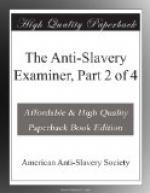We heard frequent complaints in Jamaica respecting the falling off of the crops since abolition. In order that the reader may know the extent of the failure in the aggregate island crops, we have inserted in the appendix a table showing the “exports for fifty-three years, ending 31st December, 1836, condensed from the journals of the House.”
By the disaffected planters, the diminished crops were hailed as “an evident token of perdition.” They had foretold that abolition would be the ruin of cultivation, they had maintained that sugar, coffee, rum, &c., could not be produced extensively without the whip of slavery, and now they exultingly point to the short crops and say, “See the results of abolition!” We say exultingly, for a portion of the planters do really seem to rejoice in any indication of ruin. Having staked their reputation as prophets against their credit as colonists and their interests as men, they seem happy in the establishment of the former, even though it be by the sacrifice of the latter. Said an intelligent gentleman in St. Thomas in the East, “The planters have set their hearts upon ruin, and they will be sorely disappointed if it should not come.”
Hearing so much said concerning the diminution of the crops, we spared no pains to ascertain the true causes. We satisfied ourselves that the causes were mainly two.
First. The prevailing impression that the negroes would not work well after the abolition of slavery, led many planters to throw a part of their land out of cultivation, in 1834. This is a fact which was published by Lord Sligo, in an official account which he gave shortly before leaving Jamaica, of the working of the apprenticeship. The overseer of Belvidere estate declared that he knew of many cases in which part of the land usually planted in canes was thrown up, owing to the general expectation that much less work would be done after abolition. He also mentioned one attorney who ordered all the estates under his charge to be thrown out of cultivation in 1834, so confident was he that the negroes would not work. The name of this attorney was White. Mr. Gordon, of Williamsfield, stated, that the quantity of land planted in cane, in 1834, was considerably less than the usual amount: on some estates it was less by twenty, and on others by forty acres. Now if such were the fact in the Parish of St. Thomas in the East, where greater confidence was felt probably than in any other parish, we have a clue by which we may conjecture (if indeed we were left to conjecture) to what extent the cultivation was diminished in the island generally. This of itself would satisfactorily account for the falling off in the crops—which at most is not above one third. Nor would this explain the decrease in ’34 only, for it is well known among sugar planters that a neglect of planting, either total or partial, for one year, will affect the crops for two or three successive years.




